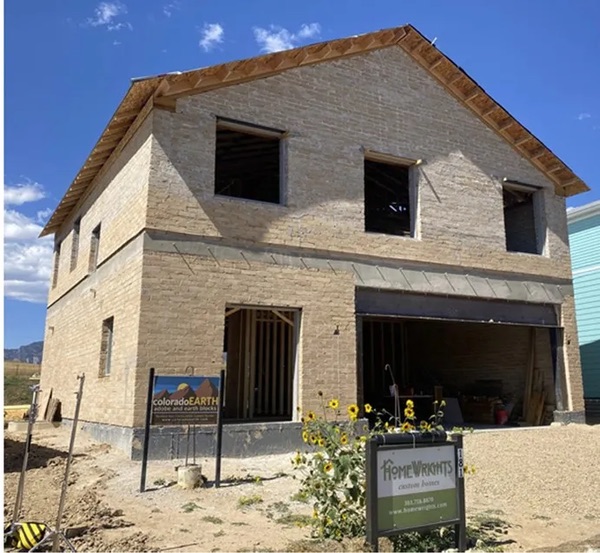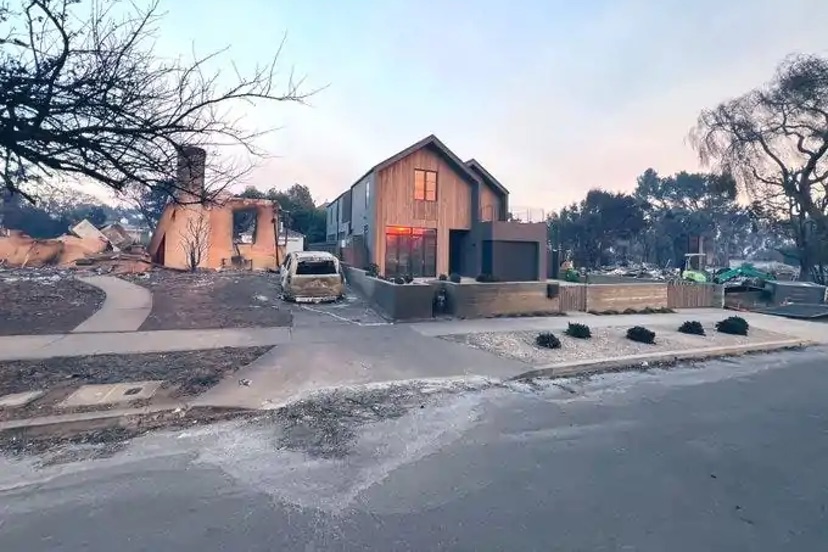This story by Jim Smith appeared on BigPivots.com on February 12, 2025.
The world watched in horror as wind-driven fires ravaged the Los Angeles area during January. For many, it’s a reminder of what might happen in our own neighborhoods.
One-third of Americans live within two miles of the wildland-urban interface, or WUI, meaning roughly 100 million Americans are at risk of wildfires. That’s 45 million residences that could be destroyed quickly, given the “perfect storm” of high winds, low humidity, and dry vegetation.
That combination led to the Marshall Fire, which destroyed over 1,000 homes in Boulder County in December 2021. As in that fire, we have now seen pictures of homes that didn’t burn amid homes that burned to the ground. At the top is one such home in Pacific Palisades. The architect, Greg Chasen, also built it. It was so hot that aluminum from a car parked on the property line flowed in a stream toward the sidewalk.
Here’s a video demonstrating the importance of keeping combustibles like shrubs and fences out of “Zone 0,” the five feet closest to any structure:
Here’s a link to CalFire’s website from which that video is taken that describes in detail how to harden your home against wildfire.
To keep fire out of a house, wind-driven embers must be prevented from entering the attic. Most homes have ventilated attics, with soffit vents to let air in and roof vents to let the air out. The Chasen house has no attic and therefore no vents.
In my October 13, 2022, column I wrote about two homes in Superior that didn’t burn because they had “conditioned” attics with no openings for ventilation. Instead of blown-in insulation resting on the attic floor, the ceilings of the attics (the underside of the roof) in both homes were insulated with closed-cell foam. In other words, attics were conditioned (heated and cooled) like the rest of the house.
It is essential to keep a home completely sealed because most fires spread through wind-blown embers. The windows should be closed, of course, but keep in mind that the framing of vinyl windows could melt, allowing the glass panes to fall out. Aluminum framing melts at 1,100º F, so metal or fire-rated wood framing is best. You could install fire shutters or roll-down steel shutters, allowing you to keep your current vinyl windows.
Embers will land on your roof, so a metal roof is best. Some attractive stone-coated steel roofs resemble wood shakes or composition shingles. Do not have plastic or vinyl gutters, and keep your gutters clear of leaves.
If you have a vented attic, you can install screens with 1/16-inch mesh that will keep 99% of embers out of the attic.
This instructive short video from the Spokane Fire Department explains that embers start most house fires:
Some building codes now require fire sprinklers, but it’s unlikely they’re installed in an unconditioned attic. If a fire enters your attic, the PVC pipes in the attic for delivering water to your top floor sprinkler heads would likely melt before the sprinklers activate, which would be too late anyway.
Wood decks, wood fences and vegetation that touches your house will receive wind-blown embers and, after burning next to your house for a while, will ignite your home. Consider rebuilding your deck with Class A wood, installing steel railings and fencing, and eliminating all vegetation within five feet of your home, especially juniper bushes, which make great kindling for starting a house fire.
If you’ll be replacing your windows, having the outer pane be tempered glass makes it much more resistant to breakage from heat, and pay attention to the window frames, as I mentioned earlier. According to AIS Glass, some tempered glass can withstand heat up to 662 degrees Fahrenheit. Aris Papadopoulos, a building resilience expert from Florida International University, told The Daily Beast that the inside of a home is like a “fuel tank,” so having durable windows can prevent sparks and embers from starting a fire.
If building a new home, adobe walls are best, because “dirt doesn’t burn.” In my Sept. 14, 2023, column I reported on a Marshall Fire home that was rebuilt using “Ecoblox,” a product of Lisa Morey’s Brighton-based startup, Colorado Earth. Ecoblox, unlike traditional bricks, are not fired, but merely compressed, giving them a lower carbon footprint, too. Here’s a picture of that home which I took in September 2023. It’s now occupied.

Building with dirt has a long and proven track record dating back 10,000 years. It is clearly the most proven material for building a fire-resistant home. Lisa built 25 homes in New Zealand before returning to the U.S. and co-authoring a book on the subject, Adobe Homes for All Climates.
China and New Zealand are leaders, it appears, in the resurgence of this building technique. See www.EarthHomes.co.nz.
You may recall that Australia had some horrendous “bushfires” several years ago. That resulted in new building codes which may be the most stringent in the world. Technology Review published an article in 2019 about their stringent new building codes. The article is behind a paywall, so if you don’t subscribe, I can send you the article.
And here’s a picture of the ultimate “bushfire-proof” home – covered with earth and with closable shutters for the windows:

Of necessity, this column only begins to deal with hardening an existing home or building a fire-resistant home. In researching this topic, I discovered a website www.WildfirePrepared.org, which has an amazingly thorough checklist of actions to take which result in the awarding of a “Wildfire Prepared Home” or “Wildfire Prepared Home Plus” certificate, which is recognized by insurers in Oregon and California, but not yet in other states. Nevertheless, it is a terrific menu of actions you could take to make your Colorado home fire-resistant.
Following the 2012 Waldo Canyon fire in Colorado Springs, that city published a 50-page Ignition Resistant Construction Design Manual.
You could lose your home in two ways. One is from the outside, where vegetation, fences and other combustibles (including decks and porches) burn against the outside of your house. That’s dealt with through the creation of defensible space.
The other is from inside, where embers enter through vents, windows and other penetrations and ignite the attic or other areas of your home. Looking at video footage of the L.A. fires, you can see homes that burned from the inside. Sealing those openings would have helped. But pay attention to both defensible space and sealing your home, because doing just one of those strategies won’t suffice to save your home.
Most Americans live in communities where houses are close enough to each other that it’s just as important for your own protection that your neighbor take the kind of actions discussed above. The National Fire Protection Association (NFPA) has a “Firewise USA” program which is focused on organizing entire communities to work together. Here’s a link to their toolkit. This toolkit provides key information and participation tips for homeowners and communities to take action to reduce wildfire risks at the local level.
This article was first published January 22, 2025, in Jim Smith’s Substack newsletter.

